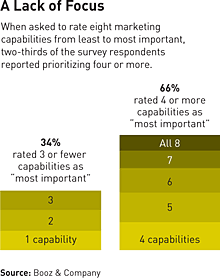How to Be a More Coherent Marketer
A recent survey highlights the challenges facing today’s marketing organizations, and reveals a path to differentiation.
The dramatic evolution of technology has fundamentally altered the way consumers approach buying decisions. Thanks to the Internet and mobile technology, they can make a purchase anytime, anywhere. The proliferation of buying channels is also enabling marketers to interact with consumers and businesses in ways that weren’t possible before. And because they have access to more and more data about consumers’ habits and preferences, marketers can tailor these interactions to maximize their impact.
Yet according to a recent multi-industry survey of 350 marketing professionals conducted by Booz & Company, Korn/Ferry International, and the Association of National Advertisers, many marketers are struggling to manage these powerful societal and technological trends. Their survey answers highlight the significant pressures that marketing organizations now face: They are being asked to do more to drive growth, with the same or fewer resources, while their spending is subjected to a new level of scrutiny. The survey also reveals that most marketers are trying to tackle these challenges by spreading their bets across a variety of activities, a multipronged approach that is leading to the incoherent use of funding, talent, and other resources.
With so much in flux and so much at stake, marketing organizations need to be strategic when it comes to managing their resources and teams. We have identified two key priorities based on our findings. First, marketing leaders need to narrow their focus, identifying ways to support the few differentiated capabilities that their company as a whole should pursue to establish a right to win — the ability to engage in any competitive market with a better-than-even chance of success — in the markets in which they compete. Second, they need to hire and retain the talent that will support their role in developing these enterprise capabilities.
Choosing the Right Capabilities
Marketing leaders agree that they need to invest more wisely in capabilities. Yet when they were asked to score these capabilities on a scale of one to seven, our survey respondents experienced difficulty prioritizing them. (See Exhibit.) In fact, 50 percent of respondents rated five or more marketing capabilities as “most important” to their company’s future success. This pursuit of multiple capabilities within the marketing function is problematic, because it tends to exacerbate a number of challenges that marketers already face. Funding constraints are particularly thorny in today’s operating environment; in our survey, funding issues ranked as the top challenge (selected by 44 percent of respondents) for companies trying to build capabilities.
Marketing organizations’ lack of focus runs counter to a critical lesson proven by leading companies in the marketplace: When it comes to capabilities, less is often more. The cover-your-bases tack that marketers seem to favor now may allow their companies to do a variety of things pretty well, but no single capability differentiates them. In contrast, companies with best-in-class marketing nearly always establish the right to win by being superior at only a select few capabilities. For instance, American Express Company has established a reputation for customer service, in part through its use of digital assets, such as open forums that help it develop personalized relationships with its customers. The company strengthens the effectiveness of its marketing efforts by tracking customer responses to its marketing messages across a range of touch points.
Leading marketers have learned to distinguish three separate classes of capabilities. Right-to-play capabilities are the basic functional capabilities, such as campaign management, media buying, and budgeting, that any marketing organization should have. Right-to-compete capabilities are those marketing capabilities that any company must have to compete effectively within its industry. These would include, for example, a customer relationship management platform in the financial-services sector, format optimization in retailing, and brand management in consumer packaged goods. The third category includes the overarching capabilities that leading companies cultivate at the right-to-win level. These capabilities, which are generally cross-functional and complex, reinforce one another as part of a single capabilities system. They link directly to the company’s fundamental strategy (its “way to play” in the market), and are relevant to most or all of its products and services. It is this coherent alignment between all the critical capabilities, the market, and the portfolio that differentiates a company from competitors.
In developing right-to-win capabilities, distinctiveness is critical. Two companies competing in the same industry can end up with completely different positioning in the market. A big part of Apple Inc.’s success, for example, is that the company combined four core capabilities — consumer insights, innovation, product and interface design, and digital marketing — to establish a coherent customer-facing identity that incorporates the company’s values and feeds its trendsetting image in the marketplace. Each company needs to tailor its choices to its strategy and positioning.
Companies also need to know when to walk away. For example, social media’s mere popularity should not automatically make it a priority for every organization; marketing leaders should weigh how important social media is to their company’s overall strategy and allocate an appropriate level of investment. The chief marketing officer at a global beverage company perhaps said it best: “Marketers must often be charged with saying ‘no’ to change, by building a clear positioning and staying with it.”
Putting the Right People in Place
Seventy-five percent of our respondents said they plan to build their marketing capabilities in-house, and 58 percent of our respondents indicated they will turn to outside partners for help. Either approach will require marketers to place more emphasis than ever before on attracting and cultivating the right talent — to drive change internally or to manage a growing network of outside partners. Yet finding people with the right skills ranked as the second most daunting challenge to building the kinds of capabilities that marketers need to succeed today.
One of the refrains that came out of the survey interviews is that senior marketing leaders, in their recruitment efforts, are struggling to find an appropriate balance between specialists and integrators. Marketing organizations need specialized talent for areas such as digital marketing, social marketing, and multimedia, but specialists often lack broad management skills. Integrators may not have knowledge of new marketing functions and activities and may not be as responsive to increased industry complexity, but their critical and creative thinking skills, combined with their ability to collaborate across specialties, are integral to the success of many marketing efforts.
Leading marketing organizations address these challenges by employing talent management systems that identify workforce requirements for delivering on their chosen business strategy. Southwest Airlines Company, for example, has made a name for itself in customer service, a differentiating capability that stems from its “hire for attitude, and train for skills” philosophy. Southwest hires people for specific roles, but the company’s cooperative culture and structured incentives encourage them to collaborate and embrace a “work hard, play hard” mind-set.
Many of our respondents pointed to the importance of developing senior marketing executives with traits that will enable them to evolve as the scope of their responsibilities changes. For instance, best-in-class senior marketing leaders demonstrate a collaborative and participative leadership style. They tend to be approachable and informal. When making decisions and solving problems, these leaders demonstrate an ability to combine creativity and decisiveness, and are comfortable with complexity and ambiguity. Success comes from encouraging behaviors that yield the desired results. Google Inc. understands this better than most companies. To encourage innovation and agility, the company requires employees to spend 20 percent of their time on projects of their own choosing.
But attracting the right talent is only one part of the equation. People need to see how their roles will evolve over time if they are going to stay with the company and remain productive and creative contributors. Survey respondents who described their company as a leader in its respective market were more likely than self-described market followers to be focused on providing a competitive career path for marketing employees. For example, in shifting its talent system to address a shortage of leaders, Royal Dutch Shell PLC identified talent within the company by focusing on technical skills and leadership ability. The development program was customized for frontline, midlevel, and executive staffers, and was incorporated into the company’s university relations and diversity initiatives.
A Focused Approach
Given the increasing pressures and disruptive forces they face, marketing organizations can’t be blamed for trying to be everything to everyone. With so many opportunities to connect with consumers and businesses in new ways, it is difficult for marketing leaders to know which capabilities are worth pursuing. But the success of top marketing organizations has demonstrated that playing a key role in two or three differentiating capabilities, tied to the company’s overall capabilities system, is far better than being above average in many.
Once these right-to-win capabilities are established, marketing leaders can methodically evaluate their talent needs, create tailored compensation and incentive programs to drive capability-building behaviors, and attract and cultivate the kinds of future leaders who will enable their companies to adapt and succeed in any environment. A marketing organization that engages in capability building and talent development in this careful and coherent way will put itself in a position to face mounting pressures and prove its worth to its company’s overall strategic mission during these rapidly changing times.![]()
Reprint No. 12202
Author profiles:
- Thomas Ripsam is a partner with Booz & Company’s organization, change, and leadership practice, and is based in Florham Park, N.J.
- Yogesh Pandit is a principal in Booz & Company’s consumer, media and digital practice, and is based in New York.
- Caren Fleit is a senior client partner based in Korn/Ferry International’s New York office.
- Also contributing to this article were Booz & Company principal Josh Peters and Korn/Ferry International senior client partner Jennifer Carroll.




